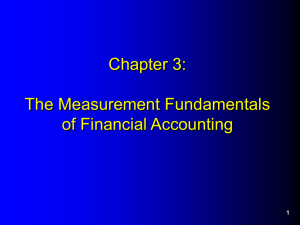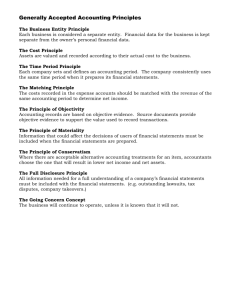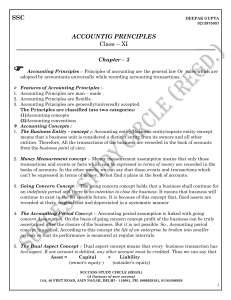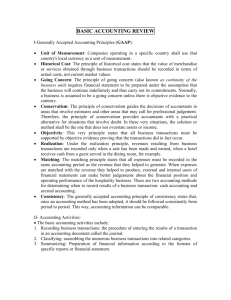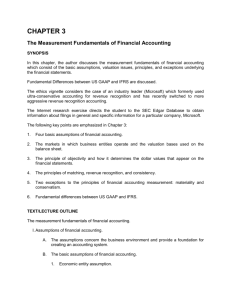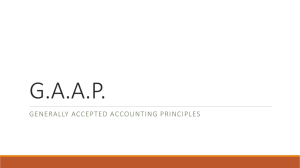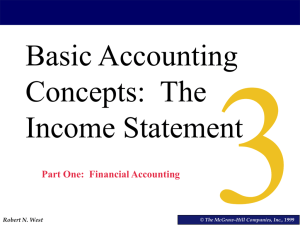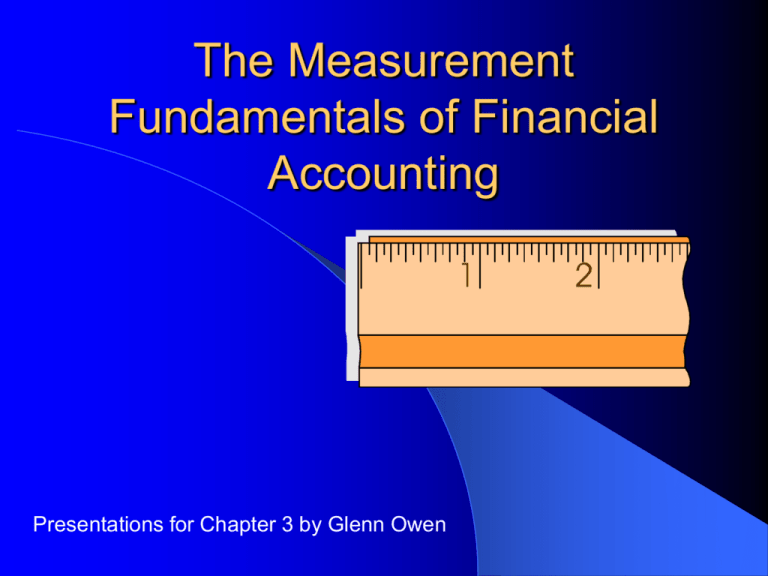
The Measurement
Fundamentals of Financial
Accounting
Presentations for Chapter 3 by Glenn Owen
Key Points
Four basic assumptions of financial accounting.
The markets in which business entities operate and the valuation
basis used on the balance sheet.
The principle of objectivity and how it determines the dollar
values that appear on the financial statements.
The principles of matching, revenue recognition, and
consistency.
Two exceptions to the principles of financial accounting
measurement: materiality and conservatism.
Basic Assumptions
Economic entity
Fiscal period
Going concern
Stable dollar
Economic Entity
A company is assumed to be a separate
economic entity that can be identified and
measured.
This concept helps determine the scope of
financial statements.
Examples — Disney and ABC, General
Electric and NBC.
Fiscal Period
It is assumed that the life of an economic
entity can be broken down into accounting
periods.
The result is a trade-off between objectivity
and timeliness.
Alternative accounting periods include the
calendar or fiscal year.
Going Concern
The life of an economic entity is assumed to
be indefinite.
Assets, defined as having future economic
benefit, require this assumption.
Stable Dollar
The value of the monetary unit used to measure an
economic entity’s performance and position is
assumed stable.
If true, the monetary unit must maintain constant
purchasing power.
Inflation, however, changes the monetary unit’s
purchasing power.
This is considered an unrealistic assumption and
thus places a limit on the financial statements as a
tool for analysis.
Valuations on the
Balance Sheet
Input market
– Purchase of materials, labor, overhead
Output market
– Sales of services or inventories
Alternative valuation bases
– Present value
– Fair market value
– Replacement cost
– Original cost
Present Value
as a Valuation Base
Discounted future cash inflows and
outflows
For example, the present value of a notes
receivable is calculated by determining the
amount and timing of its future cash inflows
and adjusting the dollar amounts for the
time value of money.
Fair Market Value
as a Valuation Base
Sales price or the value of goods and
services in the output market.
For example, accounts receivable are valued
at net realizable value which approximates
fair market value.
Replacement Cost
as a Valuation Base
Current cost or the current price paid in the
input market.
For example, inventories are valued at
original cost or replacement cost, whichever
is lower.
Original Cost as a
Valuation Base
Input price paid when originally purchased.
For example, land and property used in a
company’s operations are all valued at
original cost.
Principles of Financial
Accounting Measurement
Objectivity
Matching
Revenue recognition
Consistency
The Objectivity Principle
This principle requires that the values of
transactions and the assets and liabilities
created by them be verifiable and backed by
documentation.
For example, present value is only used
when future cash flows can be reasonably
determined.
The Revenue
Recognition Principle
This principle determines when revenues can be
recognized.
This principle triggers the matching principle,
which is necessary for determining the measure of
performance.
The most common point of revenue recognition is
when goods or services are transferred or provided
to the buyer.
Revenue Recognition
Current
Period
Decide when
revenue is to be
recognized?
Revenue
1. Significant portion of
production and effort
complete?
2. Amount of revenue
objectively measured?
3. Major portion of costs have
been incurred?
4. Collection of cash reasonably
assured?
YES
NO
Future
Period
Revenue
The Matching Principle
This principle states that the efforts of a
given period should be matched against the
benefits they generate.
For example, the cost of inventory is
capitalized as an asset on the balance sheet
and not recorded in Cost of Goods Sold
until sold.
The Matching Process
Incur cost in
current period
to generate
revenue
Current
Period
If current period,
then expense cost
in current period
Decide what
period revenue is
to be recognized?
Revenue
Future
Period
Revenue
Expense
Expense
If future period, then
capitalize cost on the
balance sheet and
expense in future periods
The Consistency Principle
Generally accepted accounting principles
allow a number of different, acceptable
methods of accounting.
This principle states that companies should
choose a set of methods and use them from
one period to the next.
For example, a change in the method of
accounting for inventory would violate the
consistency principle.
Exceptions to the
Basic Principles
Materiality
– Only transactions with amounts large enough to make a
difference are considered material.
– Nonmaterial transactions are ignored
Conservatism
– When in doubt
Understate assets
Overstate liabilities
Accelerate recognition of losses
Delay recognition of gains
COPYRIGHT
Copyright © 2003, John Wiley & Sons, Inc. All rights reserved.
Reproduction or translation of this work beyond that permitted in
Section 117 of the 1976 United States Copyright Act without the
express written permission of the copyright owner is unlawful.
Request for further information should be addressed to the
Permissions Department, John Wiley & Sons, Inc. The purchaser
may make back-up copies for his/her own use only and not for
distribution or resale. The Publisher assumes no responsibility
for errors, omissions, or damages, caused by the use of these
programs or from the use of the information contained herein.

